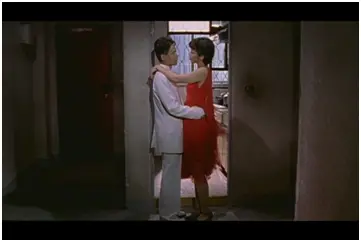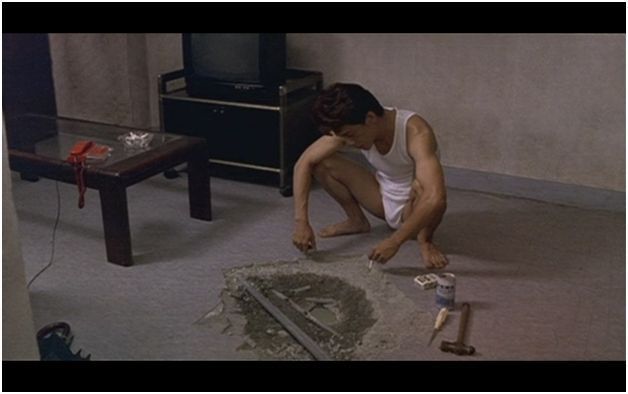The Hole (洞)
Director: Tsai Ming-liang
Written by: Tsai Ming-liang, Yang Pi-ying
Country: Taiwan
Year: 1998
This is a bad review. As per the convention, let me get over with the story quickly. [SPOILERS ALERT] “Taiwan Virus” plagues the building. The two main characters a man (Kang-Sheng Lee) and a woman (Kuei-Mei Yang) are adjacent neighbors. A plumber drills a hole in the floor while trying to fix a broken pipe, in Kang’s room from where he can peep into the woman’s room. Then, the characters eat, sleep, clean rooms until the girl catches the virus, the film ends with both characters falling in love with each other. [/SPOILERS ALERT]
Tsai Ming Liang, one of the most celebrated directors of Taiwanese cinema is ruthlessly idiosyncratic about the kind of films he wants to make. Nothing much happens in his films that try to accentuate the drama. “The Hole” is about the plague which could’ve been easily dramatized but it is not. It would be false to claim the premise of the film that of a plague to be mundane but it will be even more fallacious to state the treatment of the story as an ornate drama. Despite of the plague the tenants of the place continue their lives as if nothing has happened. There is no hurry to make a plot and put characters in perspectives. We have to wait and wait further more for the action to develop. When nothing much happens in the shot, there is no new information to process, no character quirks to remember, no dialogues to listen to, time is fore grounded. Liang holds each shot for a while even after the information in it is ingested challenging the idea of time in film which gives rise to a new experience. When the action is shown in real time or at least that tries to mirror the real time, the time factor becomes similar to our real time experience helping us to connect to a story. Film is an abstraction, and the time experience becomes the foremost factor in achieving the realistic look that is required for any film. The aim of the filmmaker is to be realistic, not to imitate reality. Even in fiction when a filmmaker is making a film about fairies and demons he has to treat his work with same sincerity as one would do while making a documentary about the holocaust.
Liang’s films aren’t a spectacle; look at the costume, location and the choice of expression that he chooses for the actors to portray. They don’t contain vehement emotions but rather insipid daily actions like walking, eating and cleaning. It’s remarkable how such mundane actions capture our attention. He uses long shots, both in length and distance from the action. He uses empty spaces in long corridors and big rooms to isolate the characters and emphasize their emptiness in the lives. It is interesting to note that apart from a cycling kid, a plumber, people spraying antidote smokes, a diseased old man and the people trying to remove him from the building, you don’t see anyone in the movie; even in phone conversations, the voice from the opposite caller is unheard.
The cuts are less frequent; he doesn’t like to move between too many vantage points. When the space and the time are concentrated the cuts become more effective as there is virtually no change in the ambience and mood from one shot to another. The pace of the film is languid and life like, there is no hurry. This is the type of film which focuses on mood foremost than anything else. From the first shot to the end there is a constant mood, and it along with concentrated time and space becomes one of the primary factors in binding a movie as a whole.
Sound wise, it is a cinema of silence. There are hardly any dialogues. He uses the sound of radio/TV announcements in conjunction with the actors performing daily actions to make the film more efficient. He utilizes the sound of the rain to monotonous effect to create mood and to establish continuity to help make unified time experience in the film.

Liang is a director of world-class pedigree. He somehow manages to make a musical about the plague. It’s not clear whether the dance sequences are dream or not but what it seems to suggest is that it has become a habit for people to be lost in their own fantasy world. Even in the extreme circumstance where people are dying we don’t seem care, we have grown so insensitive to that. The characters are loners. There is nothing to say and nobody to say it to.
We know the plot, the characters, and their dialogues but every time we watch it, the film transcends everything and looks more like a fragment of life captured on camera. Fiction isn’t documenting. There should be certain amount of creative element while at the same time making the art more realistic. Every art at least good art becomes a source of experience. By continually filming those characters in a confined space, Liang makes us observers to feel like voyeurs peeping into their lives.
With all of this Liang has been able to touch an exceptional height of the truly great cinema. This is the film for the modern times, dealing with a contemporary issue about isolation and solitude but all is not dark and at the end there is hope. His cinema comes not as a spectacle but as an observation of the daily mundane life. From within it we realize the special force that binds all human beings together and rejoice in this extraordinary capability.
See other review on the blog: The Hole.
- Decoding time, space and others in Tsai Ming Liang’s the Hole - December 21, 2014
- Late Spring - December 7, 2014
